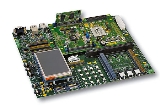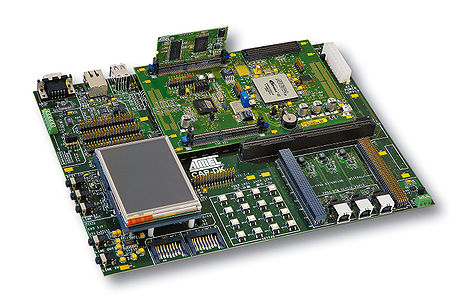
AT91CAP
Encyclopedia
AT91CAP is a family of Atmel
microcontroller
s based on the 32-bit
RISC
microprocessors from ARM
. They include a block of metal-programmable logic gate
s (MP Block) that can be personalized by the application developer. The MP Block can contain one or more additional processor
cores, additional peripheral
s or interfaces
, or application-specific logic such as a GPS
correlator.
CAP products feature embedded SRAM
and ROM
memories and an external bus for additional memories including flash memory
, together with a number of peripherals and standard communications and networking interface
s. This qualifies them as system-on-a-chip
devices.
External interfaces include USB
, CAN, Ethernet
, SPI
, USART and ADC
. A DMA
controller provides direct communication channels between external interfaces and memories, increasing data
throughput with minimal processor intervention.
Peripherals include counter/timers, power-on reset
generators, voltage regulator
s and advanced interrupt controller. This enhances the real time
performance of the processor. A power management
controller keeps power consumption to a minimum by powering down unused peripherals and interfaces, and enabling the processor to be put in standby mode.
The AT91CAP comes in both ARM7
and ARM9
versions.
The CAP design flow emphasizes parallel hardware
/software
development. An FPGA
-based emulation
board enables the hardware and software of the application under development to be thoroughly tested at close to full operational speed in order to validate the functionality of the device.

Atmel
Atmel Corporation is a manufacturer of semiconductors, founded in 1984. Its focus is on system-level solutions built around flash microcontrollers...
microcontroller
Microcontroller
A microcontroller is a small computer on a single integrated circuit containing a processor core, memory, and programmable input/output peripherals. Program memory in the form of NOR flash or OTP ROM is also often included on chip, as well as a typically small amount of RAM...
s based on the 32-bit
32-bit
The range of integer values that can be stored in 32 bits is 0 through 4,294,967,295. Hence, a processor with 32-bit memory addresses can directly access 4 GB of byte-addressable memory....
RISC
Reduced instruction set computer
Reduced instruction set computing, or RISC , is a CPU design strategy based on the insight that simplified instructions can provide higher performance if this simplicity enables much faster execution of each instruction. A computer based on this strategy is a reduced instruction set computer...
microprocessors from ARM
ARM architecture
ARM is a 32-bit reduced instruction set computer instruction set architecture developed by ARM Holdings. It was named the Advanced RISC Machine, and before that, the Acorn RISC Machine. The ARM architecture is the most widely used 32-bit ISA in numbers produced...
. They include a block of metal-programmable logic gate
Logic gate
A logic gate is an idealized or physical device implementing a Boolean function, that is, it performs a logical operation on one or more logic inputs and produces a single logic output. Depending on the context, the term may refer to an ideal logic gate, one that has for instance zero rise time and...
s (MP Block) that can be personalized by the application developer. The MP Block can contain one or more additional processor
Central processing unit
The central processing unit is the portion of a computer system that carries out the instructions of a computer program, to perform the basic arithmetical, logical, and input/output operations of the system. The CPU plays a role somewhat analogous to the brain in the computer. The term has been in...
cores, additional peripheral
Peripheral
A peripheral is a device attached to a host computer, but not part of it, and is more or less dependent on the host. It expands the host's capabilities, but does not form part of the core computer architecture....
s or interfaces
Interface (computer science)
In the field of computer science, an interface is a tool and concept that refers to a point of interaction between components, and is applicable at the level of both hardware and software...
, or application-specific logic such as a GPS
Global Positioning System
The Global Positioning System is a space-based global navigation satellite system that provides location and time information in all weather, anywhere on or near the Earth, where there is an unobstructed line of sight to four or more GPS satellites...
correlator.
CAP products feature embedded SRAM
Static random access memory
Static random-access memory is a type of semiconductor memory where the word static indicates that, unlike dynamic RAM , it does not need to be periodically refreshed, as SRAM uses bistable latching circuitry to store each bit...
and ROM
Read-only memory
Read-only memory is a class of storage medium used in computers and other electronic devices. Data stored in ROM cannot be modified, or can be modified only slowly or with difficulty, so it is mainly used to distribute firmware .In its strictest sense, ROM refers only...
memories and an external bus for additional memories including flash memory
Flash memory
Flash memory is a non-volatile computer storage chip that can be electrically erased and reprogrammed. It was developed from EEPROM and must be erased in fairly large blocks before these can be rewritten with new data...
, together with a number of peripherals and standard communications and networking interface
Computer bus
In computer architecture, a bus is a subsystem that transfers data between components inside a computer, or between computers.Early computer buses were literally parallel electrical wires with multiple connections, but the term is now used for any physical arrangement that provides the same...
s. This qualifies them as system-on-a-chip
System-on-a-chip
A system on a chip or system on chip is an integrated circuit that integrates all components of a computer or other electronic system into a single chip. It may contain digital, analog, mixed-signal, and often radio-frequency functions—all on a single chip substrate...
devices.
External interfaces include USB
Universal Serial Bus
USB is an industry standard developed in the mid-1990s that defines the cables, connectors and protocols used in a bus for connection, communication and power supply between computers and electronic devices....
, CAN, Ethernet
Ethernet
Ethernet is a family of computer networking technologies for local area networks commercially introduced in 1980. Standardized in IEEE 802.3, Ethernet has largely replaced competing wired LAN technologies....
, SPI
SPI
SPI may refer to:-Companies:* Shotmed Paper Industries, an Egyptian paper manufacturer* Simulations Publications, Inc., an American publisher of board wargames* Sony Pictures Imageworks, a visual effects and animation company...
, USART and ADC
Analog-to-digital converter
An analog-to-digital converter is a device that converts a continuous quantity to a discrete time digital representation. An ADC may also provide an isolated measurement...
. A DMA
Direct memory access
Direct memory access is a feature of modern computers that allows certain hardware subsystems within the computer to access system memory independently of the central processing unit ....
controller provides direct communication channels between external interfaces and memories, increasing data
Data
The term data refers to qualitative or quantitative attributes of a variable or set of variables. Data are typically the results of measurements and can be the basis of graphs, images, or observations of a set of variables. Data are often viewed as the lowest level of abstraction from which...
throughput with minimal processor intervention.
Peripherals include counter/timers, power-on reset
Power-on reset
A power-on reset generator is a microcontroller or microprocessor peripheral that generates a reset signal when power is applied to the device...
generators, voltage regulator
Voltage regulator
A voltage regulator is an electrical regulator designed to automatically maintain a constant voltage level. A voltage regulator may be a simple "feed-forward" design or may include negative feedback control loops. It may use an electromechanical mechanism, or electronic components...
s and advanced interrupt controller. This enhances the real time
Real-time computing
In computer science, real-time computing , or reactive computing, is the study of hardware and software systems that are subject to a "real-time constraint"— e.g. operational deadlines from event to system response. Real-time programs must guarantee response within strict time constraints...
performance of the processor. A power management
Power management
Power management is a feature of some electrical appliances, especially copiers, computers and computer peripherals such as monitors and printers, that turns off the power or switches the system to a low-power state when inactive. In computing this is known as PC power management and is built...
controller keeps power consumption to a minimum by powering down unused peripherals and interfaces, and enabling the processor to be put in standby mode.
The AT91CAP comes in both ARM7
ARM7TDMI
ARM7 is a generation of ARM processor designs. This generation introduced the Thumb 16-bit instruction set providing improved code density compared to previous designs. The most widely used ARM7 designs implement the ARMv4T architecture, but some implement ARMv3 or ARMv5TEJ...
and ARM9
ARM9E
ARM9 is an ARM architecture 32-bit RISC CPU family. With this design generation, ARM moved from a von Neumann architecture to a Harvard architecture with separate instruction and data buses , significantly increasing its potential speed...
versions.
The CAP design flow emphasizes parallel hardware
Computer hardware
Personal computer hardware are component devices which are typically installed into or peripheral to a computer case to create a personal computer upon which system software is installed including a firmware interface such as a BIOS and an operating system which supports application software that...
/software
Computer software
Computer software, or just software, is a collection of computer programs and related data that provide the instructions for telling a computer what to do and how to do it....
development. An FPGA
Field-programmable gate array
A field-programmable gate array is an integrated circuit designed to be configured by the customer or designer after manufacturing—hence "field-programmable"...
-based emulation
Emulator
In computing, an emulator is hardware or software or both that duplicates the functions of a first computer system in a different second computer system, so that the behavior of the second system closely resembles the behavior of the first system...
board enables the hardware and software of the application under development to be thoroughly tested at close to full operational speed in order to validate the functionality of the device.


